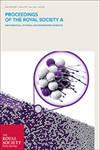多保真降阶代用模型
IF 3
3区 综合性期刊
Q1 MULTIDISCIPLINARY SCIENCES
Proceedings of the Royal Society A: Mathematical, Physical and Engineering Sciences
Pub Date : 2024-02-07
DOI:10.1098/rspa.2023.0655
引用次数: 0
摘要
在计算预算有限的情况下,对偏微分方程(PDE)进行高保真数值模拟,会大大限制所考虑的参数配置和/或评估的时间窗口的数量。多保真度代理建模的目的是在高保真数据稀缺的情况下,利用精度较低、计算成本较低的低保真度模型来提高预测精度。然而,低保真模型虽然通常能显示定性的求解行为,却无法准确捕捉高保真模型的精细时空和动态特征。为了解决这一缺陷,我们提出了一种数据驱动策略,将降维与多保真度神经网络代理相结合。其主要思路是通过对高保真解快照应用适当的正交分解(POD)来生成空间基础,并利用多保真长短期记忆网络来近似还原状态的动态--POD 基础的扩展系数与时间参数相关。通过将低保真还原态映射到高保真对应态,所提出的还原阶代用模型能够以非侵入方式有效恢复随时间和参数变化的完整解场。该方法的通用性通过一系列 PDE 问题得到了证明,在这些问题中,低保真模型可以通过更粗糙的网格和/或时间步进以及错误的物理特征来定义。本文章由计算机程序翻译,如有差异,请以英文原文为准。
Multi-fidelity reduced-order surrogate modelling
High-fidelity numerical simulations of partial differential equations (PDEs) given a restricted computational budget can significantly limit the number of parameter configurations considered and/or time window evaluated. Multi-fidelity surrogate modelling aims to leverage less accurate, lower-fidelity models that are computationally inexpensive in order to enhance predictive accuracy when high-fidelity data are scarce. However, low-fidelity models, while often displaying the qualitative solution behaviour, fail to accurately capture fine spatio-temporal and dynamic features of high-fidelity models. To address this shortcoming, we present a data-driven strategy that combines dimensionality reduction with multi-fidelity neural network surrogates. The key idea is to generate a spatial basis by applying proper orthogonal decomposition (POD) to high-fidelity solution snapshots, and approximate the dynamics of the reduced states—time-parameter-dependent expansion coefficients of the POD basis—using a multi-fidelity long short-term memory network. By mapping low-fidelity reduced states to their high-fidelity counterpart, the proposed reduced-order surrogate model enables the efficient recovery of full solution fields over time and parameter variations in a non-intrusive manner. The generality of this method is demonstrated by a collection of PDE problems where the low-fidelity model can be defined by coarser meshes and/or time stepping, as well as by misspecified physical features.
求助全文
通过发布文献求助,成功后即可免费获取论文全文。
去求助
来源期刊
CiteScore
6.40
自引率
5.70%
发文量
227
审稿时长
3.0 months
期刊介绍:
Proceedings A has an illustrious history of publishing pioneering and influential research articles across the entire range of the physical and mathematical sciences. These have included Maxwell"s electromagnetic theory, the Braggs" first account of X-ray crystallography, Dirac"s relativistic theory of the electron, and Watson and Crick"s detailed description of the structure of DNA.

 求助内容:
求助内容: 应助结果提醒方式:
应助结果提醒方式:


